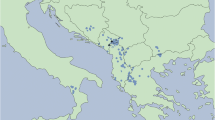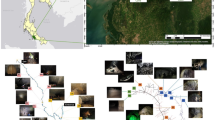Abstract
Lava tube cave ecosystems on the volcanic islands of Hawai‘i support communities of rare and highly specialized cave arthropods. In these cave ecosystems, plant roots, both living and dead, provide the main energy source for cave animals. Loss of deep-rooted plants over caves will affect populations of cave-adapted animals living below. Furthermore, the loss of native plant species will likely eliminate host specific cave animals. Thus, identification of plant roots currently found in caves is necessary for the development of effective management actions that encourage the growth of appropriate deep-rooted plant species, thereby protecting the underlying cave ecosystem. We used molecular techniques to identify plant roots found within cave ecosystems on the islands of Maui and Hawai‘i. Sequences of the internal transcribed spacer (ITS) regions and the 5.8S gene of nuclear ribosomal DNA from cave roots were compared to sequences of known plant species either collected on the surface over the footprint of each cave or to sequences accessioned in GenBank. Roots in the cave ecosystem studied on Maui belonged to two alien tree species: Eucalyptus tereticornis and Grevillea robusta. Within the Hawai‘i cave ecosystem, roots of two plant species were identified: the alien tree G. robusta and the native vine Cocculus orbiculatus. The Maui cave ecosystem supports populations of at least 28 species of arthropods, including eight that are blind obligate cave inhabitants. The Hawai‘i cave ecosystem supports 18 arthropod species, of which three are cave-adapted. Creating protected reserves around biologically significant caves, controlling, and preventing the introduction of harmful invasive plant species within the cave footprint, and encouraging the establishment of deep-rooted native plant species is essential for the continued survival of the unique ecosystems found within Hawaiian lava tube cave systems.






Similar content being viewed by others
References
Benson DA, Karsch-Mizrachi I, Lipman DJ, Ostell J, Wheeler DL (2004) GenBank: update. Nucleic Acids Res 32:D23–D26
Bouillet J, Laclau J, Arnaud M, Thongo M’Bou A, Saint-André L, Jourdan C (2002) Changes with age in the spatial distribution of roots of Eucalyptus clone in Congo impact on water and nutrient uptake. Forest Ecol Man 171:43–57
Hall TA (1999) BioEdit: a user-friendly biological sequence alignment editor and analysis program for Windows 95/98/NT. Nucleic Acids Symp Ser 41:95–98
Hoch H, Howarth FG (1993) Evolutionary dynamics of behavioral divergence among populations of the Hawaiian cave dwelling planthopper Oliarus polyphemus (Homoptera: Fulgoroidea: Cixiidae). Pac Sci 47:303–318
Hoch H, Howarth FG (1999) Multiple cave invasions by species of the planthopper genus Oliarus in Hawai‘i (Homoptera: Fulgoroidea: Cixiidae). Zool J Linn Soc 127:453–475
Howarth FG (1980) The zoogeography of specialized cave animals: a bioclimatic model. Evolution 34:394–406
Howarth FG (1983a) Ecology of cave arthropods. Ann Rev Entomol 28:365–389
Howarth FG (1983b) The conservation of cave invertebrates. In: Mylroie JE (ed) Proceedings first international cave management symposium held at Murray, Kentucky, pp 57–64
Howarth FG (1988) The evolution of non-relictual tropical troglobites. Intl J Speleology 16:1–16
Howarth FG (1991) Hawaiian cave faunas: macroevolution on young islands. In: Dudley EC (ed) The unity of evolutionary biology, vol 1. Dioscorides Press, Portland, OR, pp 285–295
Howarth FG (1996) A comparison of volcanic and karstic cave communities. In: Oromi P (ed) Proceedings seventh international symposium on Vulcanospeleology. Canary Is., Forimpres, SA, Barcelona, pp 63–68
Howarth FG, Hoch H (2004) Adaptive shifts. In: Culver DC, White WB (eds) Encyclopedia of caves. Elsevier Academic Press, Burlington, MA, pp 17–24
Jackson RB, Moore LA, Hoffmann WA, Pockman WT, Linder CR (1999) Ecosystem rooting depth determined with caves and DNA. Proc Natl Acad Sci USA 96:11387–11392
Linder CR, Moore LA, Jackson RB (2000) A universal molecular method for identifying underground plant parts to species. Mol Ecol 9:1549–1559
Smith DM (2001) Estimation of tree root lengths using fractal branching rules: a comparison with soil coring for Grevillea robusta. Plant Soil 229:295–304
Stone FD, Howarth FG, Hoch H, Asche M (2004) Root communities in lava tubes. In: Culver DC, White WB (eds) Encyclopedia of caves. Elsevier Academic Press, Burlington, MA, pp 477–484
US Fish, Wildlife Service (2000) Endangered and threatened wildlife and plants; final rule to list two cave animals from Kauai, Hawai‘i, as endangered. Fed Register 65(10):2348–2357
White TJ, Burns T, Lee S, Taylor J (1990) Amplification and direct sequencing of fungal ribosomal RNA genes for phylogenetics. In: Innis MA, Gelfand DH, Sninsky JJ, White TJ (eds) PCR protocols: a guide to methods and applications. Academic Press, San Diego, CA, pp 315–324
Acknowledgments
The authors thank the owners of ‘Ulupalakua Ranch, the staff of The Nature Conservancy of Hawai‘i, and Hiluhilu Development, LLC, for allowing us to undertake this research. We also gratefully thank: M. White and P. Bily of The Nature Conservancy of Hawai‘i and Dr. C. Puttock of Bishop Museum for providing logistical and technical support in the field on Maui; Mr. R. Harris of Hiluhilu Development, LLC, for site information and for logistical support on Hawai‘i; Dr. R. B. Rechtman of Rechtman Consulting for site information; J. Brown for field and laboratory assistance; Dr. H. Croom, Sewanee TN, for helpful suggestions on the manuscript; and the numerous colleagues who assisted with identification of the invertebrates Contribution No. 2006-034 of the Hawaii Biological Survey.
Author information
Authors and Affiliations
Corresponding author
Rights and permissions
About this article
Cite this article
Howarth, F.G., James, S.A., McDowell, W. et al. Identification of roots in lava tube caves using molecular techniques: implications for conservation of cave arthropod faunas. J Insect Conserv 11, 251–261 (2007). https://doi.org/10.1007/s10841-006-9040-y
Received:
Accepted:
Published:
Issue Date:
DOI: https://doi.org/10.1007/s10841-006-9040-y




